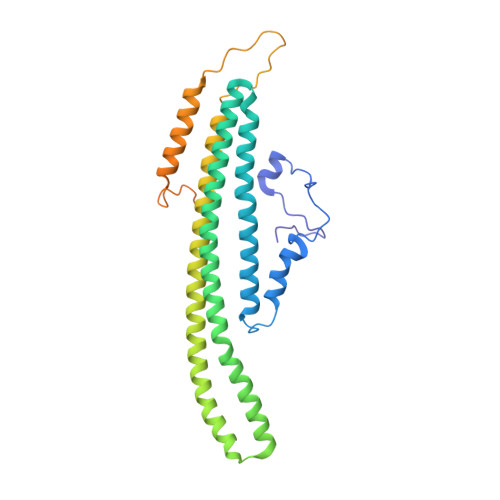Cryo-EM architecture of a near-native stretch-sensitive membrane microdomain.
Kefauver, J.M., Hakala, M., Zou, L., Alba, J., Espadas, J., Tettamanti, M.G., Gajic, J., Gabus, C., Campomanes, P., Estrozi, L.F., Sen, N.E., Vanni, S., Roux, A., Desfosses, A., Loewith, R.(2024) Nature 632: 664-671
- PubMed: 39048819
- DOI: https://doi.org/10.1038/s41586-024-07720-6
- Primary Citation of Related Structures:
8QB7, 8QB8, 8QB9, 8QBB, 8QBD, 8QBE, 8QBF, 8QBG - PubMed Abstract:
Biological membranes are partitioned into functional zones termed membrane microdomains, which contain specific lipids and proteins 1-3 . The composition and organization of membrane microdomains remain controversial because few techniques are available that allow the visualization of lipids in situ without disrupting their native behaviour 3,4 . The yeast eisosome, composed of the BAR-domain proteins Pil1 and Lsp1 (hereafter, Pil1/Lsp1), scaffolds a membrane compartment that senses and responds to mechanical stress by flattening and releasing sequestered factors 5-9 . Here we isolated near-native eisosomes as helical tubules made up of a lattice of Pil1/Lsp1 bound to plasma membrane lipids, and solved their structures by helical reconstruction. Our structures reveal a striking organization of membrane lipids, and, using in vitro reconstitutions and molecular dynamics simulations, we confirmed the positioning of individual PI(4,5)P 2 , phosphatidylserine and sterol molecules sequestered beneath the Pil1/Lsp1 coat. Three-dimensional variability analysis of the native-source eisosomes revealed a dynamic stretching of the Pil1/Lsp1 lattice that affects the sequestration of these lipids. Collectively, our results support a mechanism in which stretching of the Pil1/Lsp1 lattice liberates lipids that would otherwise be anchored by the Pil1/Lsp1 coat, and thus provide mechanistic insight into how eisosome BAR-domain proteins create a mechanosensitive membrane microdomain.
Organizational Affiliation:
Department of Molecular and Cellular Biology, University of Geneva, Geneva, Switzerland.














